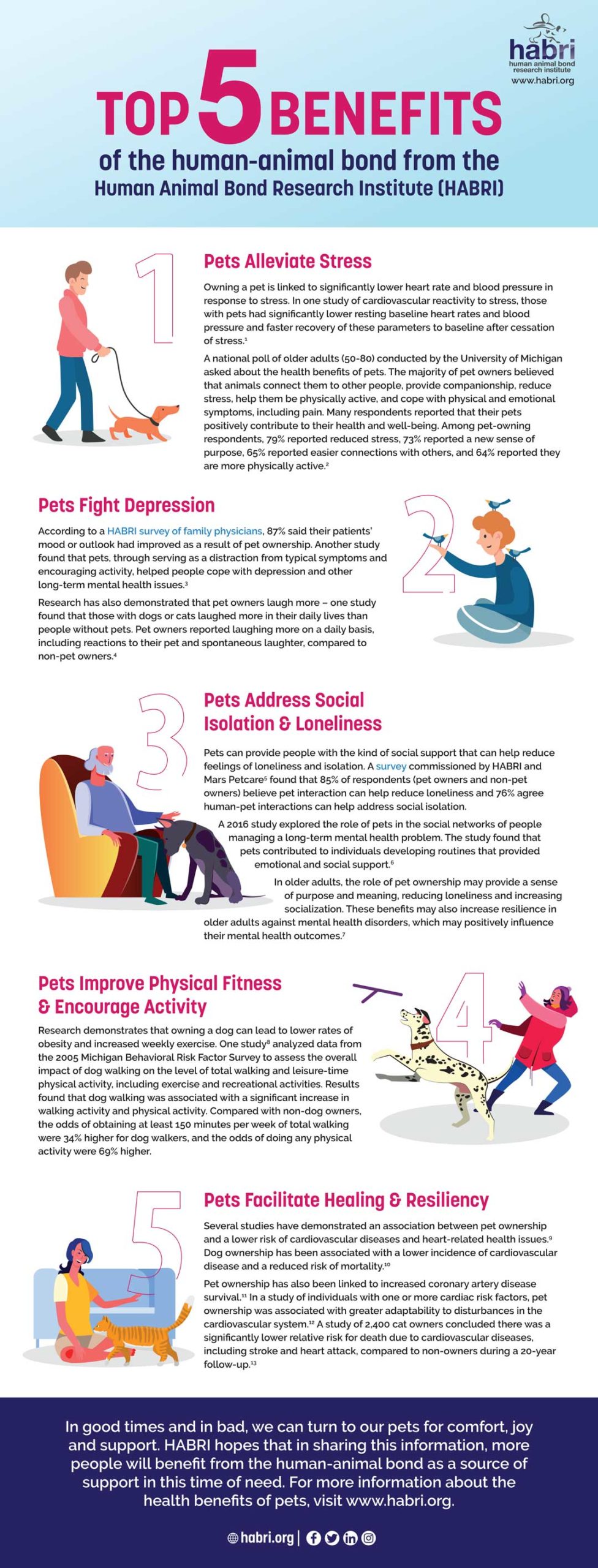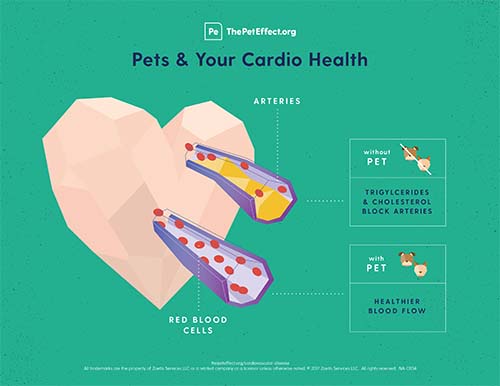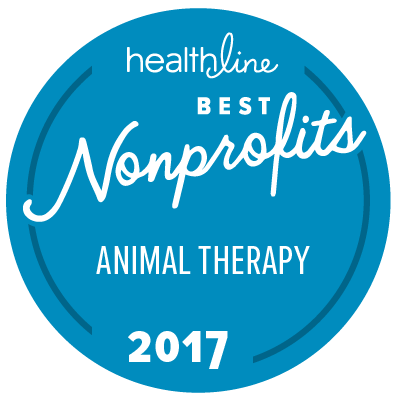Ask any pet owner and they’ll agree, pets enrich our lives.
Did you know? There’s scientific research that supports the human-animal bond – or the mutually beneficial relationship between people and pets – for a happier, healthier life.
HABRI has created this new infographic highlighting the benefits of a healthy relationship with a pet.
HABRI hopes that in sharing this far and wide, we can encourage people to take care of their pets and remind them that in good times and in bad, our companion animals can be wonderful sources of comfort, joy and support.
Please consider posting this infographic on your social media channels, websites and with your colleagues, friends and family to help us strengthen the human-animal bond for all!
References
- Allen, K., Blascovich, J., & Mendes, W. B. (2002). Cardiovascular reactivity and the presence of pets, friends, and spouses: The truth about cats and dogs. Psychosomatic medicine, 64(5), 727-739.
- Janevic, M., Solway, E., Malani, P., Kirch, M., Kullgren, J., & Connell, C. (2019). National Poll on Healthy Aging: How pets contribute to healthy aging.
- Brooks, H., Rushton, K., Walker, S., Lovell, K., & Rogers, A. (2016). Ontological security and connectivity provided by pets: a study in the self-management of the everyday lives of people diagnosed with a long-term mental health condition. BMC psychiatry, 16(1), 409.
- Valeri, R. M. (2006). Tails of laughter: A pilot study examining the relationship between companion animal guardianship (pet ownership) and laughter. Society & Animals, 14(3), 275-293.
- HABRI, Social Isolation & Loneliness
- Brooks, H., Rushton, K., Walker, S., Lovell, K., & Rogers, A. (2016). Ontological security and connectivity provided by pets: a study in the self-management of the everyday lives of people diagnosed with a long-term mental health condition. BMC psychiatry, 16(1), 409.
- Hui Gan, G. Z., Hill, A. M., Yeung, P., Keesing, S., & Netto, J. A. (2020). Pet ownership and its influence on mental health in older adults. Aging & mental health, 24(10), 1605-1612.
- Reeves, M. J., Rafferty, A. P., Miller, C. E., & Lyon-Callo, S. K. (2011). The impact of dog walking on leisure-time physical activity: results from a population-based survey of Michigan adults. Journal of Physical Activity and health, 8(3), 436-444.
- Levine, G. N., Allen, K., Braun, L. T., Christian, H. E., Friedmann, E., Taubert, K. A., … & Lange, R. A. (2013). Pet ownership and cardiovascular risk: a scientific statement from the American Heart Association. Circulation, 127(23), 2353-2363.
- Mubanga, M., Byberg, L., Nowak, C., Egenvall, A., Magnusson, P. K., Ingelsson, E., & Fall, T. (2017). Dog ownership and the risk of cardiovascular disease and death–a nationwide cohort study. Scientific reports, 7(1), 1-9.
- Friedmann, E., & Thomas, S. A. (1995). Pet ownership, social support, and one-year survival after acute myocardial infarction in the Cardiac Arrhythmia Suppression Trial (CAST). The American journal of cardiology, 76(17), 1213-1217.
- Aiba, N., Hotta, K., Yokoyama, M., Wang, G., Tabata, M., Kamiya, K., … & Masuda, T. (2012). Usefulness of pet ownership as a modulator of cardiac autonomic imbalance in patients with diabetes mellitus, hypertension, and/or hyperlipidemia. The American journal of cardiology, 109(8), 1164-1170.
- Qureshi, A. I., Memon, M. Z., Vazquez, G., & Suri, M. F. K. (2009). Cat ownership and the Risk of Fatal Cardiovascular Diseases. Results from the Second National Health and Nutrition Examination Study Mortality Follow-up Study. Journal of vascular and interventional neurology, 2(1), 132.





